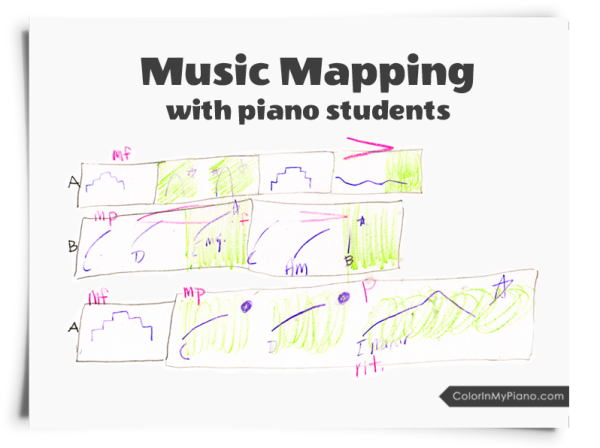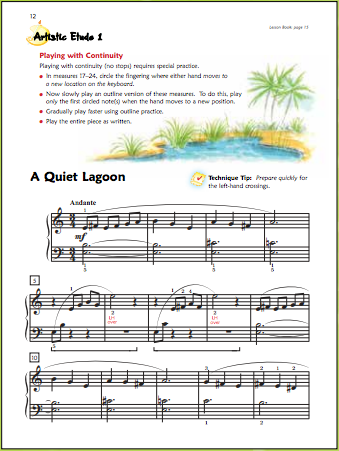With nearly every piece I teach, the student and I analyze and label the form: Q&A phrases, AB form, ABA form, sonata form, etc.. Understanding the structure of a piece helps the student learn the piece more thoroughly and make well-based decisions relating to the interpretation of a piece.
Back in early March, a student of mine demonstrated he had his piece memorized all the way through but found he was “fuzzy” on the details in certain places and could not always remember what came next between phrases without taking time for thought. In a moment of inspiration (or perhaps desperation!), we decided to construct a visual map of the piece — an activity I have found to be beneficial in the past with certain students. I took a blank sheet of paper from my printer and handed my student a few colored pencils. Taking a few minutes to turn our analysis into a simple, visual graphic proved to strengthen and clarify his memory of the piece.
During my college years, I was exposed to this kind of music mapping thanks to a book I found in the university library: Mapping Music: For Faster Learning and Secure Memory, by Rebecca Payne Shockley. She shares many examples in her book to learn from, but emphasizes that music mapping is a very personal thing: the map must primarily make sense to the person who makes it.

As you can see from the image above, we used boxes to represent the 4-bar phrases as well as the larger A and B sections. Within each box, my student drew lines or shapes to represent the melodic contour of the phrases. We also added a few chord symbols to help mentally clarify the B section and the ending.
As a final step, we added dynamic markings in pink and green shading to represent pedaling.
 After completing the music map, I asked my student to play the piece by memory again. It was not a perfect performance, but it was definitely better because his memory of the piece’s structure was stronger and more clear.
After completing the music map, I asked my student to play the piece by memory again. It was not a perfect performance, but it was definitely better because his memory of the piece’s structure was stronger and more clear.
After creating a map, it should not be necessary to have the student read from the music map while playing, although that is an option. The point of the exercise is to be able to rely on a strong, mental picture of the piece during performance. In my student’s own words: “It’s the process of creating the map that is beneficial; not the finished map itself.”
Have you ever created a music map with a student?
[Note: In case you are interested, the piece my student was learning is called “A Quiet Lagoon” by Dennis Alexander and Martha Mier. We were using a sampler piece of sheet music I received during a conference, but the piece is readily available in the Technique Book Level 2B of the Alfred Premier Piano Course.]



I really love this idea! This is really taking advantage of visual thinking.
I like how you organized your map — we talk a lot about form during lessons, and we label sections in the music, but I really think the “map” idea will help even more. Thanks for sharing this, Joy!
Thank you, Sara!
The idea of mapping pieces has always intrigued me, but I have never seriously tried using it, either for myself or with students. I bought Rebecca Shockley’s book on mapping decades ago, but couldn’t make my way further than a few pages into it. My brain just doesn’t work that way! I am very visual and tactile. But obviously for other learning styles it does make sense, so I am going to revisit this and try it with a couple of students who have been struggling. Thanks for including both the music and your maps. This is very clear and complete.
Hi Kathy! Yes, I do remember seeing Rebecca Shockley’s book at a library some years back. Her approach is one that is far more specific and detailed, but I don’t think music mapping necessarily has to be. I prefer a looser approach where the student calls upon their own creativity and personal impressions of the music to create the map. My inspiration is the use of “listening maps” often used in classroom music education settings for understanding the form and texture of the great classical works.
Great idea! Have you ever tried it with younger students, in the earlier books such as 1a or 1b levels? I have a lot of young students and I’m not sure how to apply it well to them.
Yes, it works well for any age/level student. Younger students just require a little more prompting and more suggestions about what kind of lines or shapes to draw to represent the phrases. As with any student, the first music map experience will require much teacher help. Each time the activity is repeated, the student will become more independent.
I have seen Music Mapping drawn out before but haven’t thought of actually drawing one with students. I can see how it would really help them to understand the structure of the piece better and in memorization. Great idea!